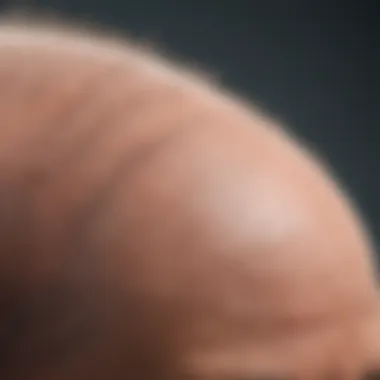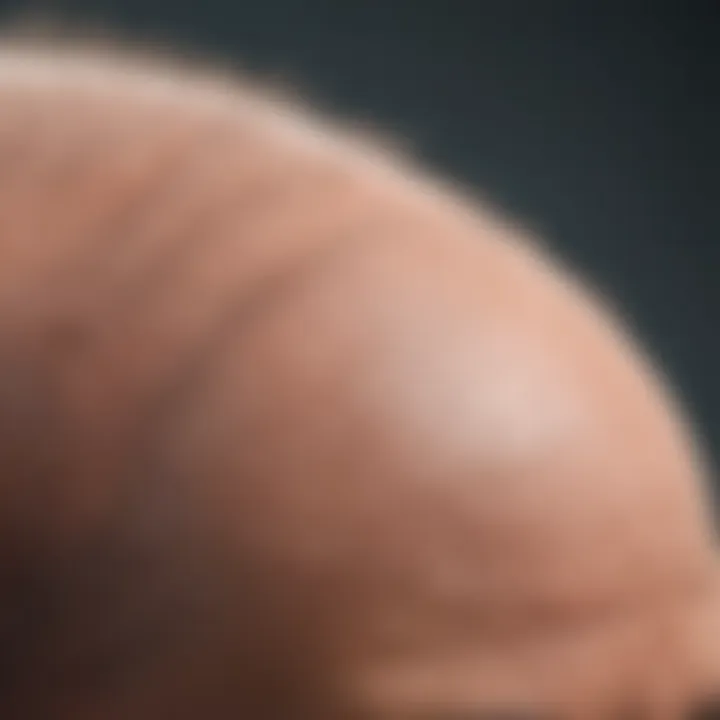Understanding the Main Cause of Male Baldness


Intro
Male baldness is a pressing issue that affects a significant portion of the male population. It is often a source of concern or self-consciousness. This phenomenon, scientifically known as androgenetic alopecia, has multiple contributing factors that intertwine genetics, hormones, and lifestyle.
As we delve into the main causes of this condition, it is essential to understand how these elements create the framework for hair loss in men. Genetic predisposition plays a crucial role, but it does not operate in isolation. The hormonal imbalances and environmental influences further complicate this picture.
In the following sections, we will dissect these causes in detail. Each aspect will provide insights into the intricate biological mechanisms at play, including the impact of dihydrotestosterone on hair follicles. Additionally, we will look at how lifestyle choices can exacerbate or mitigate hair loss. The objective is to give readers a comprehensive understanding of male baldness, equipping them with knowledge that might aid in addressing this common issue.
Methodology
Overview of research methods used
To explore the causes of male baldness, a comprehensive review of existing literature was conducted. Studies were selected based on relevance to androgenetic alopecia and included a mix of observational and experimental research.
Data collection techniques
Data was collected through various means:
- Literature reviews: Articles detailing genetic studies, hormonal assessments, and environmental factors were reviewed.
- Clinical studies: Research that investigated patient histories, hormonal levels, and response to treatments.
- Surveys: Questionnaire-based studies allowed insights from men experiencing hair loss, highlighting lifestyle impacts.
This blend of methods provides a strong foundation for understanding the multi-faceted nature of male baldness.
Future Directions
Upcoming trends in research
New studies are emerging focusing on the genetic markers associated with hair loss. Genome-wide association studies are providing clearer insights into the heritable factors leading to androgenetic alopecia. Additionally, research into targeted therapies that could counteract dihydrotestosterone’s effects is gaining traction.
Areas requiring further investigation
Further exploration is needed in the following areas:
- Environmental Influence: How pollution or diet contributes to hair loss.
- Hormonal Treatments: The long-term effects of various treatments, including finasteride and minoxidil, require more analysis.
- Psychological Effects: Understanding the emotional impact of baldness can lead to better support systems.
Overall, these future directions will contribute significantly to the evolving understanding of male baldness, paving the way for innovative solutions.
Prelims to Male Baldness
Understanding male baldness is crucial, given its widespread impact on men across different ages and backgrounds. Male pattern baldness, also known as androgenetic alopecia, affects a significant portion of the male population, often leading to psychological and social implications. This article provides an in-depth exploration of the factors contributing to hair loss, including genetics, hormones, and lifestyle choices.
The prevalence of male baldness has been documented extensively, but many men lack comprehensive knowledge about its causes. Gaining insights into this condition not only helps in normalizing the conversation around it but also encourages proactive measures for prevention and management.
Definition and Prevalence
Male baldness primarily refers to the thinning of hair and eventual hair loss in a patterned way, typically beginning at the temples or crown of the head. Statistics indicate that around 50% of men experience some degree of hair loss by the age of 50. The condition can start as early as one’s late teens or early twenties, indicating that it is not simply a natural part of aging.
Baldness manifests itself in various patterns, with the Ludwig and Norwood scales categorizing the stages of hair loss. The Norwood scale is particularly notable, as it outlines the progression of male pattern baldness from stage one, characterized by minimal hair loss, to stage seven, which indicates significant thinning and balding across the scalp.
Historical Perspectives on Baldness
Historically, male baldness has been regarded with mixed views. In some cultures, baldness was seen as a sign of wisdom and maturity, while in others, it was associated with negative stereotypes related to aging or health issues. Ancient texts hint at various remedies and beliefs surrounding hair loss that reflect societal attitudes of the time.
In the 20th century, the perception of baldness began to evolve, partly due to changing beauty standards and increased awareness. With advances in medical research, there is now a greater understanding of the biological mechanisms involved in hair loss, shifting the focus from stigmatization to education and treatment options.
Understanding these historical perspectives can help in appreciating the cultural context of baldness and the ongoing relevance of this issue in modern society.
Genetic Factors of Baldness
Understanding the genetic factors of baldness is crucial for comprehending why some men experience hair loss while others remain full-haired throughout their lives. Male baldness, particularly androgenetic alopecia, is often hereditary. When studying this topic, it is essential to recognize how genetics interplay with other factors, like hormones and environmental components, to influence the rate and extent of hair loss.


Role of Heredity in Hair Loss
Heredity plays a significant role in male baldness. It is common knowledge among scientists that multiple genes contribute to the characteristics of hair, including its growth cycle and density. Research indicates that men with a family history of hair loss are more likely to experience it themselves. For instance, if a man's father or grandfather suffered from baldness, the chances increase significantly for him as well.
The inheritance pattern can be complex. It does not follow a simple dominant or recessive trait. Instead, scientists have identified various gene locations associated with androgenetic alopecia. For example, one well-studied gene is the AR gene located on the X chromosome, which appears to have a high tendency to influence baldness, especially in men. Additionally, various other genes contribute to hair follicle regulation and sensitivity to hormones.
"Genetic predisposition to hair loss can make it clearer why some individuals experience substantial thinning while others do not, despite similar environmental conditions."
Identifying Baldness-Related Genes
Identifying the specific genes related to male baldness has become a focus of extensive genetic research. Researchers employ different methods to pinpoint variations in genes that could link to hair loss. Advances in genomic technologies allow scientists to identify single nucleotide polymorphisms (SNPs) that correlate with the disease.
Studies have highlighted several significant loci associated with baldness. For instance, genetics studies have revealed that the presence of certain SNPs near the EDA2R gene and the SRY gene are prevalent among men who develop baldness.
Furthermore, understanding baldness-related genes can provide insights into how hair growth cycles are disrupted in affected individuals. By studying these genes, researchers hope to develop targeted therapies or preventive strategies that could one day minimize or halt the process of hair loss.
Hormonal Influences
Hormones play a significant role in hair loss, particularly in men. Understanding how hormones contribute to male baldness is crucial for grasping the overall causes and potential treatments available for those affected. The balance of various hormones can influence hair growth cycles, follicle health, and even the rate of hair loss. One hormone that stands out in relation to male pattern baldness is dihydrotestosterone (DHT).
Preface to Dihydrotestosterone
Dihydrotestosterone is an androgen, a male sex hormone linked to hair loss. DHT is produced when testosterone interacts with the enzyme 5-alpha-reductase. This conversion can lead to increased levels of DHT in men, which then binds to androgen receptors in hair follicles. The presence of DHT can shrink hair follicles, eventually leading to their miniaturization and the subsequent thinning of hair strands.
Research has shown that higher levels of DHT correlate with the severity of androgenetic alopecia. Thus, individuals who genetically predisposed to hair loss tend to have increased DHT levels. Notably, DHT does not affect all hair follicles equally, which explains the distinct patterns seen in male baldness.
How Hormones Affect Hair Follicles
Hormones, particularly androgens like DHT, can influence hair follicles in several ways:
- Follicle Miniaturization: The binding of DHT to androgen receptors in hair follicles causes them to decrease in size. Over time, this leads to finer, shorter hair strands, and may eventually result in complete follicle shutdown.
- Altered Hair Growth Cycle: Hair follicles have a life cycle that includes phases such as growth, rest, and shedding. DHT can shorten the growth phase and increase the duration of the resting phase, which may lead to noticeable hair thinning.
- Imbalanced Hormonal Activity: An imbalance of hormones, whether due to genetic factors, lifestyle, or underlying health conditions, can exacerbate hair loss. This imbalance can disrupt normal hair cycle patterns and further contribute to hair thinning and baldness.
Understanding the exact hormonal contributions to hair loss can help inform treatment strategies. For some, medications that inhibit the conversion of testosterone to DHT can slow down or even reverse hair loss. Additionally, lifestyle changes that promote hormonal balance can also have a beneficial impact on hair health.
Key Takeaway: Dihydrotestosterone's effect on hair follicles is a primary hormonal influence in male baldness, making it a focal point for both understanding and treatment.
Environmental and Lifestyle Factors
Environmental and lifestyle factors play a critical role in the discussion of male baldness. These factors can influence the development and progression of androgenetic alopecia. While genetics and hormones lay the groundwork for hair loss, external factors significantly modulate its impact. Understanding how one’s day-to-day choices affect hair health is vital for both prevention and management of this condition.
Impact of Stress on Hair Loss
Stress is often cited as a significant factor contributing to hair loss. When experiencing high levels of stress, the body produces certain hormones that can disrupt the natural hair growth cycle. Psychologically stressful situations can lead to a condition called telogen effluvium, where a larger-than-normal number of hair follicles enter the resting phase. Consequently, hair shedding increases, contributing to apparent thinning.
Chronic stress may also exacerbate other underlying conditions that lead to hair loss. For instance, it may worsen hormonal imbalances or compromise overall health, further influencing hair quality.
"Stress is more than a feeling; it can trigger a physiological response that impacts hair growth."
Nutritional Deficiencies and Hair Health
Nutritional deficiencies can considerably affect hair quality and growth, leading to hair loss. Essential vitamins and minerals, such as B vitamins, vitamin D, iron, and zinc, are critical for maintaining healthy hair. A diet lacking these nutrients may result in weakened hair shafts and increased breakage.
- Vitamin D: Helps to create new hair follicles. Low levels can result in hair loss.
- Iron: Crucial for delivering oxygen to hair follicles; deficiency could cause hair to fall out.
- Zinc: Plays a role in tissue growth and repair, including hair.
A balanced diet rich in fruits, vegetables, lean proteins, and whole grains can enhance hair health.
The Role of Smoking and Alcohol
Smoking and excessive alcohol consumption are two lifestyle factors that can hinder hair health. The toxins in cigarette smoke reduce blood flow to the hair follicles, weakening their structure and leading to premature hair loss. Furthermore, smoking has been linked to various health complications that indirectly affect hair, such as reduced circulation and increased inflammation.


On the other hand, excessive alcohol intake can deplete essential vitamins and minerals that are important for healthy hair. It can also lead to dehydration, which may weaken hair and promote breakage. Reducing these lifestyle factors is pivotal for anyone concerned about hair loss.
Biological Mechanisms Behind Hair Loss
Understanding the biological mechanisms behind hair loss is essential for comprehending why certain individuals experience male baldness more than others. Hair loss, particularly androgenetic alopecia, is not merely cosmetic; it is rooted in complex biological processes that interconnect genetic, hormonal, and environmental factors. Recognizing how these mechanisms function can help in both prevention and treatment strategies.
The Hair Growth Cycle
The hair growth cycle consists of three primary phases: anagen, catagen, and telogen.
- Anagen Phase: This is the active growth phase. During this time, hair follicles produce new hair cells, resulting in hair lengthening. Anagen can last several years, depending on genetic factors.
- Catagen Phase: This transitional phase lasts a few weeks. Blood supply to the hair follicle diminishes, and hair growth slows down. The hair follicle begins to shrink.
- Telogen Phase: The resting phase where the hair follicle remains inactive. Eventually, the old hair sheds, making way for new growth in the next anagen phase.
In male baldness, disturbances in this cycle can lead to premature shedding during telogen, or the transition to anagen becomes impaired. Moreover, factors affecting the duration of the anagen phase or pushing follicles into premature catagen can significantly contribute to hair thinning.
This cycle is not uniform across all individuals. Genetics plays a crucial role in determining the length of each phase. For instance, one individual may have a shorter anagen phase, leading to shorter hair and more noticeable thinning over time. This variability in the hair growth cycle underlines the importance of a biological understanding of baldness.
Miniaturization of Hair Follicles
Miniaturization refers to the process by which hair follicles become smaller and produce thinner, weaker hair strands. This phenomenon is particularly pronounced in androgenetic alopecia. As hair follicles miniaturize, they may eventually stop producing visible hair altogether.
Several mechanisms contribute to this miniaturization:
- Hormonal Influence: Dihydrotestosterone (DHT), a derivative of testosterone, is a key player. High levels of DHT can bind to androgen receptors in hair follicles, leading them to shrink.
- Genetic Predisposition: Those genetically predisposed to baldness often have hair follicles that are more sensitive to DHT. This sensitivity can trigger miniaturization at a younger age and lead to quicker hair loss.
- Inflammation: Chronic inflammation around hair follicles can also induce miniaturization. This can impact hair growth lost in the previous phases and contribute to further thinning.
Effective prevention and management strategies start at understanding these biological processes. Targeting the root causes can result in more effective treatments.
In summary, recognizing how the hair growth cycle and follicle miniaturization work together provides insight into the underlying causes of male baldness. It opens avenues for research and potential therapies, helping those affected by this condition to seek informed solutions.
Diagnosis and Classification of Baldness
Diagnosing and classifying baldness is a crucial aspect of understanding male hair loss. Recognizing the type of baldness a man is experiencing can directly influence the approach to treatment and management strategies. Various types of male baldness exist, each with distinct characteristics, progression patterns, and possible interventions. This classification aids in developing a customized treatment plan that caters to individual needs.
In the clinical context, correctly identifying the specific type of baldness is essential for creating effective treatment options. Furthermore, awareness of classification helps in gathering research data, which can lead to new treatment developments. Overall, these aspects underscore the importance of accurate diagnosis and timely intervention.
Different Types of Male Baldness
Male baldness presents itself in various forms, the most common being androgenetic alopecia, also known as male pattern baldness. This condition is typically characterized by a gradual thinning of hair on the scalp, often beginning at the temples or crown. Other forms include:
- Alopecia Areata: A condition marked by sudden hair loss in distinct patches. It may affect any hair-bearing area.
- Telogen Effluvium: Temporary hair thinning often triggered by stress, hormonal changes, or nutritional deficiencies.
- Cicatricial Alopecia: A rare disease that destroys hair follicles and replaces them with scar tissue.
Each type of baldness has unique features and requires a tailored approach towards management and treatment. Recognizing these forms allows practitioners to provide more accurate advice and interventions.
Tools for Diagnosing Hair Loss
Several tools are available to assist in the diagnosis of hair loss. Clinicians often combine visual assessments with various diagnostic approaches. Some of the key tools include:
- Dermatoscopy: An examination method that utilizes a dermatoscope to closely observe the scalp and hair follicles, allowing for detailed identification of hair loss type.
- Scalp Biopsy: Involves removing small pieces of scalp skin for laboratory analysis to identify underlying conditions.
- Blood Tests: Assessing levels of hormones or nutritional deficiencies that may contribute to hair loss.
These tools provide a comprehensive understanding of the underlying causes of hair loss, ensuring that treatments are based on accurate diagnoses. In turn, this leads to improved outcomes for those experiencing male baldness.
Quote: Accurate diagnosis is the cornerstone of effective treatment in managing male baldness.
Integrating these diagnostic methods into practice will allow for more informed recommendations and personalized treatment plans, which ultimately improves the patient’s experience and satisfaction.
Current Research Trends
Current research trends in male baldness primarily focus on understanding the genetic and hormonal mechanisms driving this condition. With the increasing prevalence of androgenetic alopecia, or male pattern baldness, innovative studies have emerged that explore not just the causes but also potential solutions. These research avenues are crucial, offering hope to millions affected by hair loss.
Advancements in genetic research play a vital role in this discussion. Identifying specific genes associated with baldness provides insight into hereditary patterns. Genetic markers can guide better understanding of individual susceptibility to hair loss. This leads to the development of targeted treatments, which is an exciting prospect for many researchers and clinicians.


Advances in Genetic Research
Recent studies have pointed to multiple genes related to male baldness. Notably, the AR (androgen receptor) gene has been the focus of attention. Variants in this gene can affect how hair follicles react to hormones such as dihydrotestosterone, leading to a higher likelihood of hair loss.
- Key Findings in Genetic Studies:
- Association Studies: Large cohorts have been assessed through genome-wide association studies. These studies have identified potential genetic variants that correlate with early-onset baldness.
- Heritability Estimates: Research suggests that genetic factors account for approximately 80% of male baldness cases.
Understanding these genetic underpinnings is essential for developing personalized medicine approaches, where treatments could be tailored based on an individual’s genetic profile. This can possibly revolutionize treatment modalities and offer better success rates for interventions.
Investigating New Treatment Modalities
The investigation into new treatment modalities has gained traction alongside the advancements in genetic research. Scientists are exploring various approaches, including pharmacological solutions and regenerative therapies.
- Pharmaceutical Interventions: Medications such as finasteride and minoxidil have demonstrated efficacy. However, ongoing research is evaluating how new compounds might target the causes of male baldness more effectively.
- Regenerative Treatments: Techniques involving stem cells and hair follicle regeneration show potential. These methods could potentially reverse hair loss rather than merely mitigate symptoms.
Moreover, clinical trials are essential to assess the effectiveness and safety of emerging treatments. Research teams are utilizing advanced technologies such as CRISPR gene editing. This could allow for precise interventions at the molecular level.
"Scientific breakthroughs in hair loss treatment highlight the intersection of genetics and innovative therapies, providing hope for effective management of baldness in the future."
Prevention and Management Strategies
The discussion surrounding male baldness often focuses on its underlying causes. However, understanding how to prevent and manage this condition remains critically important. With the right approach, men can mitigate hair loss or even promote regrowth. This section will explore various strategies available for prevention and management, acknowledging both the benefits and the considerations involved in each method.
Pharmaceutical Interventions
Many pharmaceutical choices exist for those experiencing male baldness. The two primary medications are minoxidil and finasteride.
- Minoxidil: This topical solution is applied directly to the scalp. It is known to stimulate hair follicles, promoting hair regrowth in some men. It's available over-the-counter in various concentrations.
- Finasteride: This oral medication works by reducing levels of dihydrotestosterone (DHT). Lowering DHT can slow down hair loss in men with androgenetic alopecia. It is a prescription drug, and users should discuss possible side effects with their healthcare provider.
While these interventions can be effective, they may not work for everyone. Continuous use is often necessary to maintain results, as stopping can lead to further hair loss.
Natural Remedies and Their Efficacy
Natural remedies present alternative methods to manage baldness. These options range from topical treatments to dietary changes, though scientific support varies.
- Saw Palmetto: This herbal supplement may inhibit DHT production. Some studies suggest it could support hair density when taken over time.
- Pumpkin Seed Oil: Often touted for its potential to promote hair health, some small studies indicate that it may positively influence hair growth.
- Essential Oils: Certain essential oils like rosemary and peppermint are thought to improve circulation when massaged into the scalp.
Users of natural remedies should approach with caution. While some individuals may see improvements, others may not experience significant benefits. Consulting a healthcare professional is advisable before starting any new remedy.
Lifestyle Changes to Mitigate Hair Loss
Lifestyle factors play a significant role in hair health. Changing certain habits can have a positive impact on the prevention of baldness.
- Diet: Consuming a balanced diet rich in vitamins and minerals is crucial. Nutrients such as biotin, zinc, and iron support healthy hair. Incorporating more fruits, vegetables, and healthy fats might foster better hair health.
- Stress Management: Stress can worsen hair loss. Techniques such as meditation, exercise, and proper sleep contribute to overall well-being and may help mitigate hair loss.
- Avoiding Harsh Treatments: Limiting the use of harsh chemicals or heat treatments on hair can prevent further damage and loss.
Overall, the relationship between lifestyle choices and hair loss is complex. Careful consideration of these factors can lead to improved outcomes.
Culmination
The examination of male baldness is not just a study of aesthetics; it reflects underlying genetic, hormonal, and lifestyle factors that influence overall health and well-being. Understanding the roots of this condition can have significant implications for one's self-esteem and personal identity. The relevance of the discussion of male baldness in this article lies in the convergence of various domains of study, from genetics to environmental influences. This multi-faceted approach provides a more profound insight into what may appear to be a superficial issue.
Summary of Key Findings
Throughout this article, several key findings emerge regarding the causes of male baldness:
- Genetic Predisposition: Research shows a strong hereditary component, with specific genes linked to androgenetic alopecia.
- Hormonal Contributions: Dihydrotestosterone (DHT) plays a pivotal role in hair follicle miniaturization and eventual hair loss.
- Environmental & Lifestyle Factors: Stress, diet, and habits such as smoking are influential in the progression of baldness.
- Biological Mechanisms: The hair growth cycle is disrupted by factors that influence follicle sensitivity to hormones.
These findings underscore the complexity of hair loss in men and call for a holistic understanding that incorporates various influences on hair health.
Future Directions in Research
The future of research in male baldness is promising and ripe for exploration. Several essential areas warrant further investigation:
- Genetic Research: Expanding studies around baldness-related genes to identify novel pathways could lead to targeted treatments.
- Hormonal Studies: Understanding how varying levels of hormones affect hair loss may inform therapeutic approaches.
- Lifestyle Interventions: Evaluating the impact of diet and lifestyle modifications in preventing or mitigating hair loss is crucial.
- Regenerative Medicine: Advancements in stem cell therapy and follicle regeneration offer potential avenues for effective treatment.
Continued scholarly work in these areas may contribute significantly to the overall understanding of male baldness and its management.







